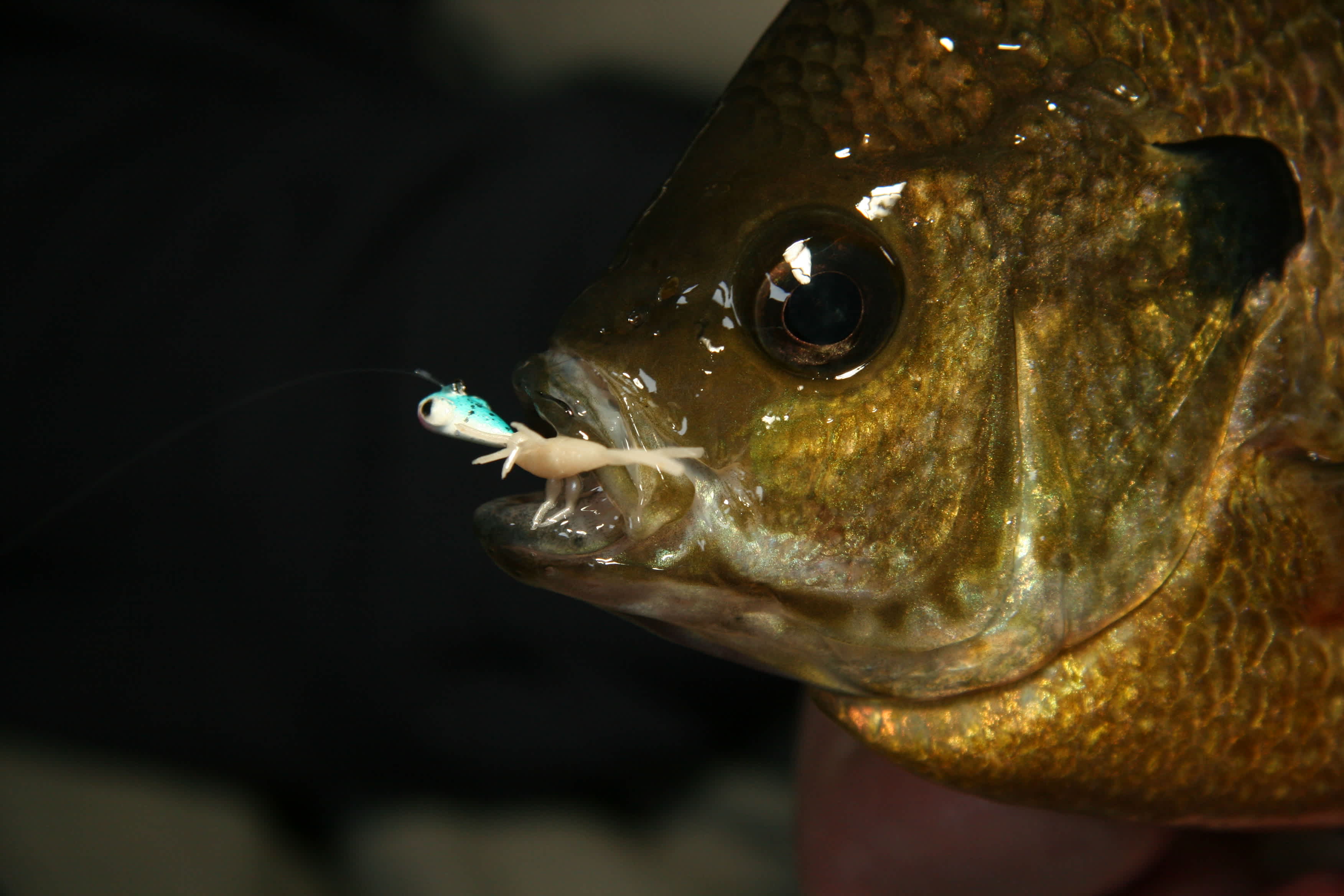Zero in on ‘The Zoo’ Bite
OutdoorHub Contributors 11.09.12

In the 1990s we discovered the benefits of downsizing to 1- to 2-pound test and using Rat Finkies and Hornets for hardwater panfish. It was incredible—we began to experience unprecedented bites on tiny horizontal jigs while guys near us fishing minnows struggled to put fish on the ice.
But it wasn’t good enough that we were catching lots of fish. Since I have a hard time accepting that fish eat just for the sake of eating, I had to find out why we were catching so many fish.
It was odd. You’d catch a bunch, keep a few, clean them and find nothing in the stomachs. But I knew they had to be eating something. So I started cutting their bellies open, dumping the milky stomach contents into Mason jars of water to better examine the contents.
What I found were tiny, dead, translucent and white zooplankton. I’ve since learned that these minute crustaceans have names like Daphnia and copepods. Definitely explained the “empty” stomachs.
It was a mind-bender. We had no idea crappies and bluegills were eating so many of these organisms. I also noticed the tiny critters had two tiny black dots on one end – exactly like the white spikes we had been tipping our jigs with.
A lightbulb went off: Here’s a predator/prey relationship. But that was only part of it.
Years later, as camera technology advanced, I submerged an HD underwater camera to capture footage of panfish bites to learn more about jigging techniques. After all, the best teacher in the world is watching fish actually respond to baits.
As soon as I started reviewing the video the screen filled with thousands of tiny white specks moving to and fro. It was like looking at a Petri dish under a microscope. Based on what I had found in crappie stomachs years prior, I could’ve guessed they’d be there, just not that many.
The camera allowed me to study how zooplankton move—and how panfish feed on them—which filled in another piece of the puzzle. I watched both bluegill and crappie responses to the colors of jigs we used. The video confirmed that white, pearlescent and glow drew more bites than pinks or chartreuses when fish were feeding on zooplankton. Simply, these colors more closely resembled the food.
Steaks vs. Shake
The next big revelation was noticing how panfish feed.
I observed both crappies and bluegills moving through clouds of zooplankton, filtering in the tiny white organisms, which motored around in chaotic patterns.
You see, fish don’t eat zooplankton like they’re eating a steak. They have to filter it. It’s like the difference between eating a milkshake and a steak. The calorie content is about the same but they’re too very different ways of eating.
The way panfish feed on zooplankton is very refined. If they open their mouth too much the zooplankton goes through the gills and out, it doesn’t go into their stomach.
This explained the almost undetectable bites, and why a super-light jig with horizontal orientation, super light line, and the right color were keys. The fish were coming to the baits off the horizontal plane and creating a suction to draw the bait into their mouth cavity. They weren’t attacking the baits. They were filter feeding, much like a whale. Also explained why a spring bobber was essential.
This is when I realized that fishing microplastics really aggressively might work a lot better than live bait.
Top Picks for ‘The Zoo Bite’
I think a lot of guys miss out on some phenomenal fishing by not paying attention to what’s going on. The fish may be on a wide-open bite but if you’re sitting there sinking a minnow for crappies, you’re just not going to catch numbers of fish. The fish aren’t shut off or going negative; chances are they’re aggressive and eating as much zooplankton as they can get.
But switch over to 1-pound test, a tiny Northland Gill-Getter, Mooska or Tungsten Fire-Ball UV Jig and there’s a good possibility that you’re going to leave the guys fishing big baits with heavier gear in the snow.
One of the best jigs out there is the Gill-Getter. The head is like what you’d find on a mayfly, a wiggler or a hellgrammite but it sits very horizontal. It has the right shape and a 60-degree bend to the Mustad Ultra-Point hook. Tie to your line with a Palomar or improved clinch and it should sit perfectly horizontal.
The past couple of years we’ve had huge success with all of the above ice jigs in Northland’s Slug color, which is basically white with a hint of pink. Glow White also works well. And there’s no better microplastic currently available to take full advantage of the ‘Zoo Bite’ than the Northland Impulse Micro Mayfly in Glow White.
However, if the bite slows I’ll switch to a Brown Micro Mayfly on a Woodtick-colored Gill-Getter to tap fish that may be getting conditioned to my presentation. It works well with fish that are transitioning into or out of a ‘Zoo Bite’ for other forage. I’ll ice two or three fish with the dark color and then move back to the white. It’s a great switch-up tactic.
Go For It
Make sure that you spend some time experimenting this winter with ‘Zoo Bite’ techniques. Don’t abandon vertical presentations and sinking minnows for crappies, or waxies and larger larvae for ‘gills, but do pay close attention to what the fish are doing, especially when you see tons of fish on your electronics, but they just won’t bite. Make sure you’re set up with a spring bobber, 1- or 2-pound test and super-small jig heads and microplastics. We’re willing to bet you’re going to discover some great panfish action in situations where you would’ve been scratching your head!

